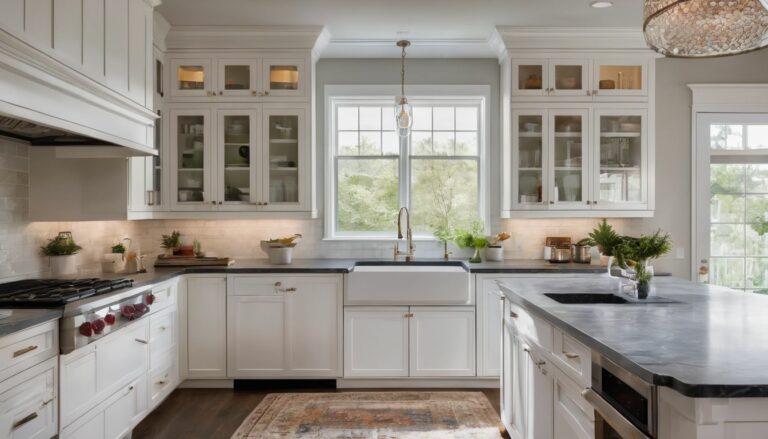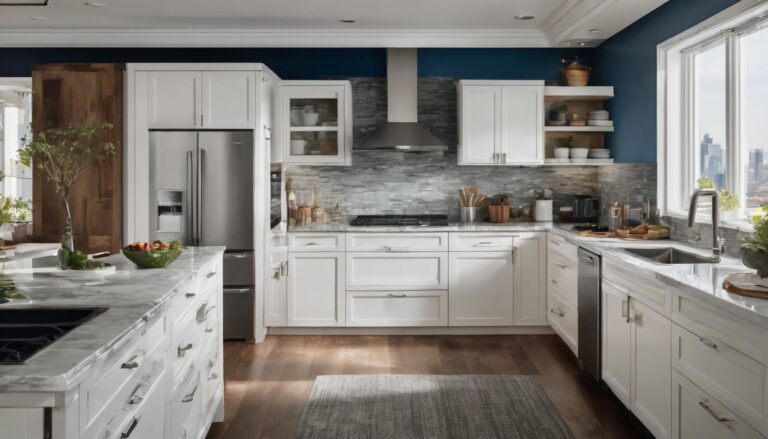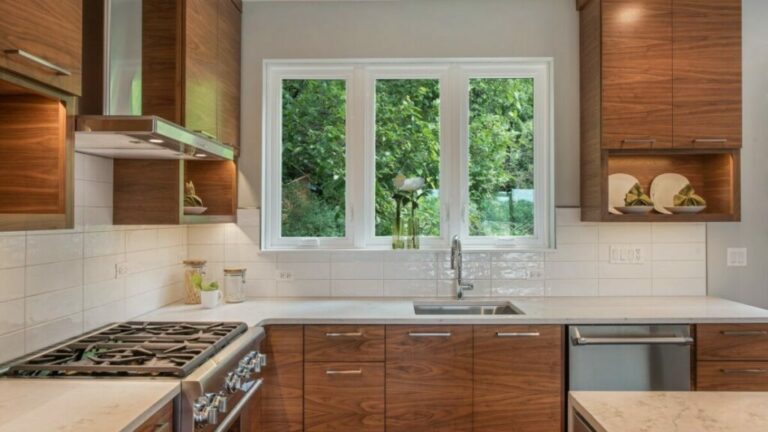Can Bathroom And Kitchen Vent Together: Essential Ventilation Tips
Have you ever pondered, ‘Can bathroom and kitchen vent together?’ Imagine the convenience of combining your home’s ventilation into a single, effective system. This captivating concept isn’t just a thought experiment—I’ve explored this innovative, space-saving solution myself and encountered a major obstacle.
But here’s the thing: our friend the building code is crystal clear on this matter – a shared exhaust venting for these two rooms is a big no-no. In today’s article, we’re going to peel back the layers on this rule, delve into potential consequences of blurring boundaries and explore some efficient alternatives for home ventilation.
Are you ready to untangle some truths about household ventilation with me? Let’s dive right in!
Key Takeaways
- Bathroom and kitchen ventilation systems should not be vented together due to different purposes, code restrictions, and practical issues with combined ducting.
- Combining the exhaust fans can lead to problems such as insufficient airflow, noise, cross contamination of odors, increased risk of grease buildup, and potential health hazards.
- Separate ducting for each fan or using backdraft preventers is recommended to maintain proper ventilation and prevent unwanted smells from spreading between rooms.
- Following code regulations on venting systems is crucial for safety and functionality. Failure to comply may result in penalties, fines, and safety hazards.
Why Combining Bathroom and Kitchen Ventilation Systems is Not Recommended
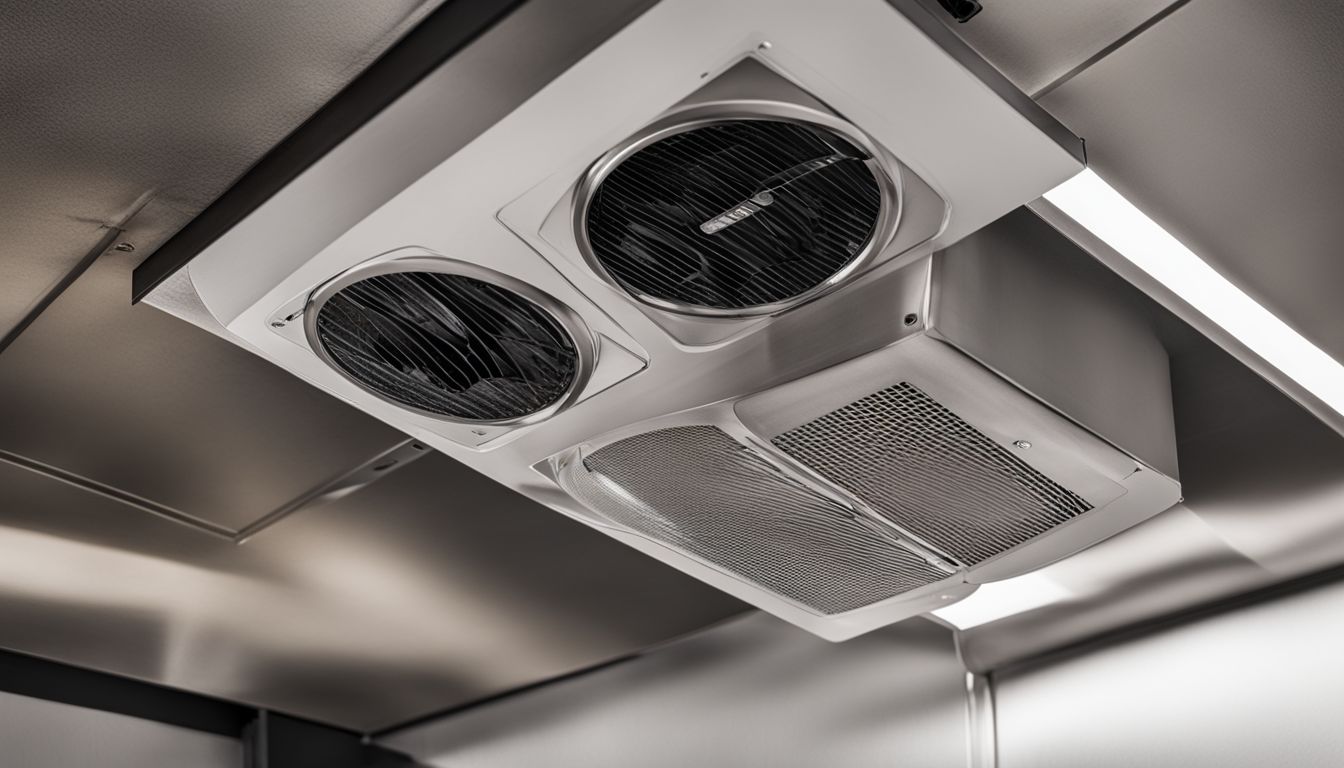
Combining bathroom and kitchen ventilation systems is not recommended due to the different purposes of exhaust fans, code restrictions, and practical issues with combined ducting.
Different purposes of exhaust fans
Exhaust fans in your bathroom and kitchen have different jobs. In the bathroom, they get rid of extra water in the air. This stops mold from growing, which is good for your family’s health.
The fans also clear out smells from cleaning products or other things in the air. Now let’s talk about kitchen fans called range hoods. These are strong! They suck up smoke and food fumes when you’re cooking a meal.
So, even though both kinds of fans remove stuff from the air, they do very different tasks at home.
Code restrictions
The codes say no to joining kitchen and bathroom vents. Rules like the International Mechanical Code are clear on this. They don’t allow systems with fire risks to link up. OSHA guidelines back this up too.
These rules come from lessons learned over time. For example, the Minnesota Mechanical Code says Type I exhaust systems must stand alone. This is because mixing fan types can lead to fires.
So, we see that code restrictions have a big role in keeping our homes safe from fire hazards.
Practical issues with combined ducting
Mixing ducts for the bathroom and kitchen can lead to problems. One issue is that it doesn’t provide enough air flow for both areas. Kitchen exhaust needs strong flow to get rid of cooking smells and smoke.
Bathroom fans need airflow to pull out damp air after a shower or bath. If they share one duct, neither room gets enough fresh air.
Another problem is noise. Poor kitchen ducting creates loud fan noise in your home.
The worst problem is safety. Allowing grease from the kitchen into shared ducts increases fire risk. This could be very dangerous if there were a stove-top fire! To keep our homes safe, we must separate these systems.
Can Bathroom and Kitchen Vent Together: The Two Ventilation Systems Work Differ
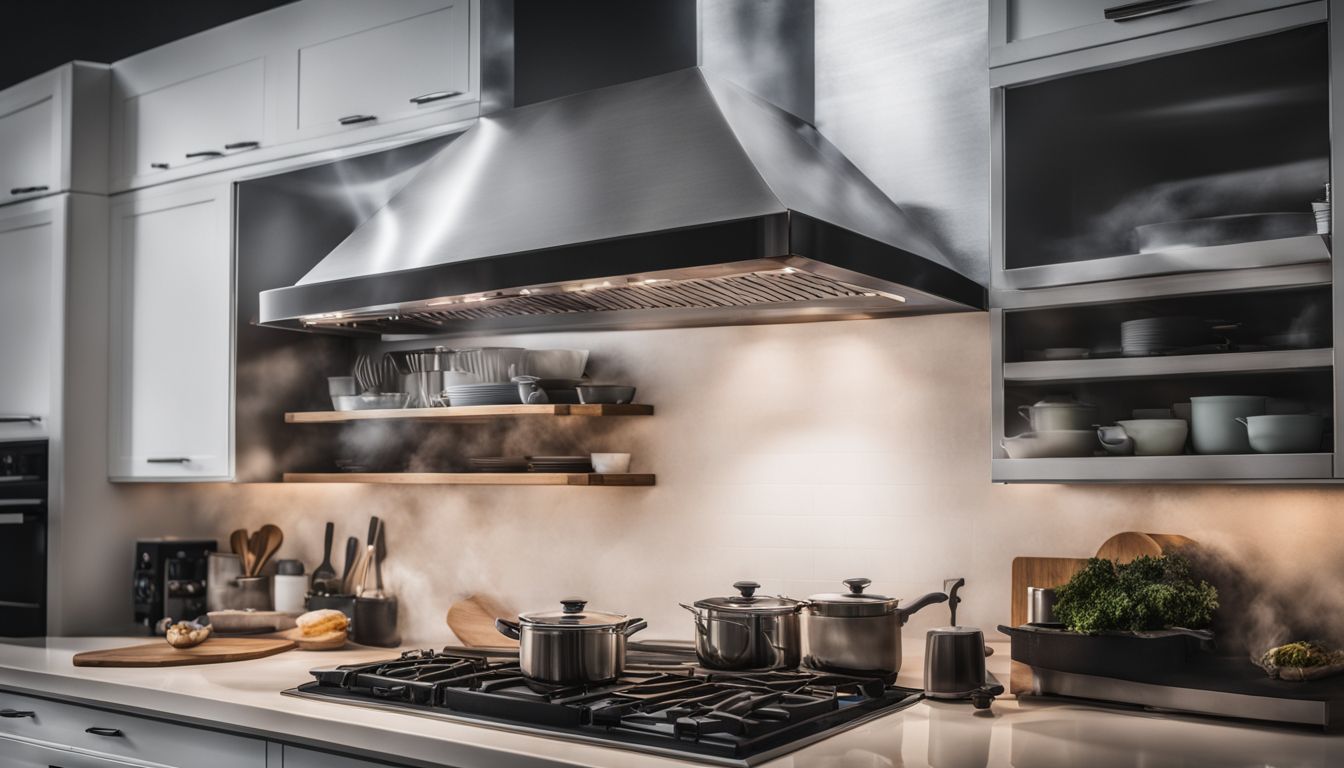
Bathroom exhaust fans remove moisture and odors from the air after bathing or using the toilet, while kitchen range hood fans extract smoke, grease, and cooking odors generated during meal preparation.
Function of bathroom exhaust fans
Bathroom exhaust fans are important for keeping our bathrooms clean and fresh. They have a specific function, which is to remove excess moisture, humidity, and odors from the bathroom.
When we take showers or baths, the hot water creates steam that can linger in the air. The exhaust fan helps to get rid of this moisture by drawing it out of the room. This not only helps prevent mold and mildew growth but also reduces humidity levels, making our bathrooms more comfortable.
Additionally, these fans help eliminate unpleasant odors by venting them outside instead of letting them linger inside. So, bathroom exhaust fans play a crucial role in maintaining proper ventilation and improving indoor air quality in our bathrooms.
Role of kitchen range hood fans
In the kitchen, range hood fans play a crucial role in keeping the air clean and fresh. They help remove pollutants, odors, smoke, and grease that can be generated during cooking. Range hoods are designed for exhaust-only ventilation, meaning they effectively expel heat and contaminants outside of your home.
It’s important to have a properly installed and ducted kitchen exhaust fan to ensure its effectiveness in removing these pollutants from the air we breathe. So when you’re cooking up a storm, make sure to turn on your range hood fan for better air quality in your kitchen.
Potential Consequences of Sharing Exhaust Ducts
Sharing exhaust ducts between bathroom and kitchen ventilation systems can lead to cross contamination of odors, increased risk of grease buildup, and potential health hazards.
Cross contamination of odors
I want to share an important fact about the potential consequences of sharing exhaust ducts between bathroom and kitchen ventilation systems. One major concern is the cross contamination of odors.
This means that if the bathroom and kitchen fans share a common exhaust duct, there is a possibility for smells from one area to travel into the other space. Imagine cooking something with strong odors in the kitchen, and then having those smells linger in your bathroom! To prevent this issue, it’s best to have separate ducting for each fan or use backdraft preventers to control the flow of air and stop odors from mixing between rooms.
Remember, proper ventilation is key for maintaining good air quality and preventing unwanted smells from spreading around your home.
Increased risk of grease build-up
Grease build-up in ventilation systems can pose a serious risk, especially in commercial kitchens. These grease deposits are highly flammable and can lead to severe fires. In fact, government statistics show that nearly half of all structural fires in commercial kitchens are caused by grease in ventilation systems.
If the ducting of kitchen exhaust is not properly done, it can also reduce the airflow, resulting in inefficient ventilation. To prevent these risks, it’s important to regularly clean and maintain your ventilation system to minimize the buildup of grease.
Health hazards
Sharing exhaust ducts between bathroom and kitchen ventilation systems can pose potential health hazards. When these ducts are combined, there is a risk of cross-contamination of odors, which means that unpleasant smells from the kitchen can travel into the bathroom and vice versa.
Additionally, sharing exhaust ducts increases the risk of grease buildup in the ventilation system. This grease buildup can lead to clogs and reduce the effectiveness of the exhaust fans, resulting in poor indoor air quality.
Another important health concern is the increased possibility of exposure to harmful substances such as fumes, mists, vapors, and gases. Sharing exhaust ducts may cause pollutants from one area to be drawn into another space through the shared system.
For example, if there are harmful chemicals or gases released during cooking in the kitchen, these may contaminate the bathroom air when using a combined venting setup.
Proper ventilation is crucial for maintaining a healthy indoor environment. It helps prevent the accumulation of potentially dangerous substances like carbon monoxide and radon gas indoors.
By following separate systems for bathroom and kitchen ventilation with dedicated ductwork for each fan’s exhausting needs ensures that odors remain contained within their respective spaces while also minimizing health risks associated with shared airflow paths.
Code Regulations on Venting Systems
The International Mechanical Code outlines the regulations for venting systems, which are important to follow for the safety and functionality of your home. Find out more about these code requirements and why they matter in our blog post!
International Mechanical Code
The International Mechanical Code (IMC) is a set of regulations that establishes minimum standards for mechanical systems, including ventilation systems. It was developed with input from the industry and is widely used as a model code.
The IMC focuses on ensuring safe and efficient operation of buildings by providing guidelines for the design and installation of ventilation systems. One important aspect covered by the IMC is the ability to vent bathroom and kitchen ventilation systems together.
This code provides requirements to prevent issues like backdrafting and inadequate ventilation in combined venting systems.
Importance of following code requirements
It is crucial to follow code requirements when it comes to bathroom and kitchen ventilation systems. These regulations ensure the safety and efficiency of the exhaust fans in these areas.
By complying with code regulations on venting systems, we can prevent potential fire hazards and ensure that appliances like stove hoods and bathroom fans function properly. Non-compliance with these requirements can result in penalties, fines, and even safety hazards for occupants.
So, it’s important to consult local building codes and regulations to make sure your ventilation system meets all the necessary standards. Remember, following code requirements not only keeps you safe but also improves air quality by removing moisture, odors, and pollutants from indoor spaces.
Practical Considerations
When it comes to shared duct placement and preventing smells from traveling, there are some practical considerations you need to keep in mind. But don’t worry, I’ll guide you through it all! Read on to learn more.
Shared duct placement
When it comes to venting bathroom and kitchen exhaust systems, shared duct placement is not recommended. This is because building codes prohibit the use of shared exhaust ducts for these purposes.
It may seem convenient to combine the ductwork for both ventilation systems, but it can lead to problems such as cross-contamination of odors and increased risk of grease buildup. Instead, it is best to have individual ducting for each fan or dedicate a separate duct for the kitchen range hood fan.
By following proper venting practices, we can ensure adequate ventilation in our bathrooms and kitchens while avoiding any potential issues that may arise from shared duct placement.
Preventing smells from traveling
To prevent smells from traveling between the bathroom and kitchen, there are a few practical considerations to keep in mind. First, it’s important to make sure that the shared duct placement is designed in a way that minimizes cross-contamination of odors.
This means separating the ventilation systems as much as possible and avoiding any direct connections between them.
Another effective way to prevent smells from traveling is by using odor control mechanisms such as carbon filters or air purifiers. These devices help to neutralize and eliminate unpleasant odors before they have a chance to spread throughout your home.
Lastly, maintaining proper ventilation in both the bathroom and kitchen can go a long way in preventing smells from lingering. Regularly running exhaust fans in these areas helps to remove fumes and odors quickly, ensuring that your indoor air quality remains fresh and clean.
Alternative Options for Venting
One alternative option for venting is to have individual ducting for each fan, ensuring that there is no cross-contamination of odors or risk of grease build-up. Another option is to have a dedicated duct specifically for the kitchen range hood fan, preventing any potential health hazards.
These alternative options provide more effective and efficient ventilation for bathrooms and kitchens. Find out more about these options by reading the full blog post!
Individual ducting for each fan
When it comes to venting bathroom and kitchen ventilation systems, installing individual ducting for each fan is the recommended option. This means having separate ducts for the bathroom exhaust fan and the kitchen range hood fan.
It ensures that each system can work efficiently and effectively without interfering with one another. By having dedicated ducts, you can prevent odors from traveling between rooms and minimize the risk of grease build-up in your ventilation system.
Whether you have multiple bathrooms or a multifamily building with existing exhaust systems, opting for individual ducting provides better control over air circulation and helps maintain a healthy indoor environment.
Dedicated duct for kitchen range hood fan
I highly recommend using a dedicated duct for your kitchen range hood fan. This means having a separate duct just for the range hood, instead of combining it with other ventilation systems like the bathroom exhaust fan.
By doing this, you can ensure proper airflow and prevent cross-contamination of odors between the kitchen and bathroom. It also reduces the risk of grease build-up and potential health hazards.
Following this practice is in line with code regulations, such as the International Mechanical Code, which emphasizes proper venting for kitchen exhaust equipment. When installing the dedicated duct, it’s best to use rigid ductwork for optimal performance.
Proper Ventilation for Bathrooms and Kitchens
Ensure optimal air quality and prevent issues like mold and moisture buildup by understanding the importance of proper ventilation in bathrooms and kitchens. Discover how to choose the right exhaust fan size and type, as well as maintenance tips for optimal performance.
Importance of adequate ventilation for these rooms
Proper ventilation is crucial for both bathrooms and kitchens. It helps maintain fresh and healthy indoor air quality, prevents the buildup of mold and mildew caused by excess moisture, and reduces the risk of health issues like allergies, respiratory problems, and headaches.
Adequate ventilation in these rooms also plays a role in preventing the spread of respiratory viruses such as COVID-19. Moreover, good ventilation is an important aspect of energy-efficient homes as it maintains a balance between air circulation and energy conservation.
How to determine correct size and type of exhaust fan
Determining the correct size and type of exhaust fan is important for proper ventilation in bathrooms and kitchens. Here are some steps to help you choose the right fan:
- Check local building codes: Building regulations provide guidelines on airflow requirements and ventilation guidelines for different room sizes.
- Consider square footage: Measure the square footage of your bathroom or kitchen to determine the minimum airflow needed. For bathrooms up to 100 square feet, the recommended minimum airflow is 1 CFM per square foot of floor space.
- Use CFM measurement: CFM stands for Cubic Feet per Minute, which indicates how much air an exhaust fan can move. The rule of thumb for bathroom exhaust fan sizing is 1 CFM per square foot of space. For example, a 50-square-foot bathroom would require a fan with a minimum airflow of 50 CFM.
- Consult professionals: If you’re unsure about the size and type of exhaust fan you need, it’s best to consult with professionals who can assess your specific needs and recommend the right product.
Maintenance and Cleaning of Exhaust Vents
Regular maintenance and cleaning of exhaust vents is essential to prevent clogs and optimize performance. Discover effective techniques to keep your ventilation system running smoothly and improve indoor air quality.
Regular maintenance to prevent clogs and buildup
Regular maintenance is essential to prevent clogs and buildup in bathroom and kitchen ventilation systems. Proper maintenance helps ensure that the exhaust fans are working efficiently and effectively. Here are some important steps to follow for regular maintenance:
- Clean the exhaust fan grilles: Dust and debris can accumulate on the grilles, obstructing airflow. Regularly remove the grilles and clean them with a mild detergent to keep them free from dirt.
- Check for blockages in the ducts: Inspect the ducts for any blockages caused by debris or pests. If you notice any obstructions, clear them immediately to maintain proper airflow.
- Clean or replace filters: Some exhaust systems have filters that trap grease or particles from the air. Clean or replace these filters as recommended by the manufacturer to prevent clogs and ensure optimal functioning.
- Inspect and clean the exhaust hood: The exhaust hood over your kitchen stove can collect grease, which can lead to clogs and decreased performance. Regularly clean it using a degreaser to remove any buildup.
- Remove dust and lint from bathroom fans: Dust and lint can accumulate inside bathroom fans, reducing their efficiency over time. Use a vacuum cleaner or brush to remove any dust or lint from the fan blades, motor, and housing.
Cleaning techniques to ensure optimal performance
Regular cleaning is necessary for bathroom and kitchen exhaust vents to ensure optimal performance. Here are some cleaning techniques that you can use:
- Bathroom exhaust vents:
- Clean the grill and motor every six months to prevent dust buildup.
- Scrub the grill with a soft sponge or cloth, rinse it thoroughly, and allow it to air dry.
- Remove any dirt or debris from the fan blades using a vacuum cleaner or a brush.
- Check for any clogs in the vent pipe and remove them if necessary.
- Kitchen exhaust vents:
- Clean the grease filters regularly to prevent clogging in the vent pipe.
- Soak the filters in warm soapy water for about 15 minutes, then scrub them gently with a brush or sponge.
- Rinse the filters thoroughly to remove any leftover soap residue.
- Allow the filters to air dry completely before putting them back.
Conclusion
In conclusion, it is not recommended to combine bathroom and kitchen ventilation systems. Building codes prohibit it, and there are practical issues with sharing the same ducting. This can lead to cross contamination of odors, increased risk of grease build-up, and health hazards.
It is important to follow code regulations and consider alternative options for proper venting in each room separately. Adequate ventilation is crucial for maintaining indoor air quality and preventing problems like clogs and buildup.
FAQs
1. Can bathroom and kitchen ventilation systems vent together?
No, it is not recommended to vent bathroom and kitchen ventilation systems together as they serve different purposes and have different air quality requirements.
2. Why can’t bathroom and kitchen ventilation systems vent together?
Bathroom ventilation systems remove moisture and odors from the bathroom, while kitchen ventilation systems remove smoke, grease, and cooking smells from the kitchen. Venting them separately ensures that each area receives proper ventilation.
3. What problems can occur if bathroom and kitchen ventilation systems are vented together?
If bathroom and kitch


